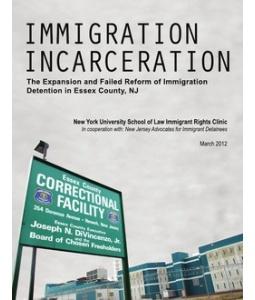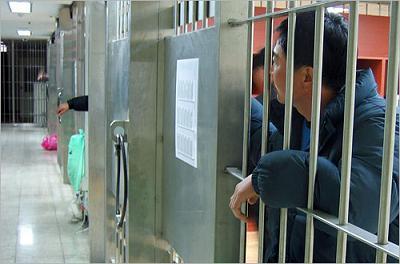Immigrant Detention in the United States: Hope and Change, or More of the Same?
March 28, 2012
On Tuesday, March 13, the Obama administration showed off the federal government’s new immigrant detention facility in Karnes County, Texas to journalists and immigrant rights advocates. According to John Morton, the director of U.S. Immigration and Customs Enforcement (ICE), the agency within the Department of Homeland Security that oversees the jailing of immigrants, the Karnes County Civil Detention Center “represents a first in the entire history of immigration detention. Karnes and others like it,” he says, are one part of an ICE detention reform program that is sensible, sustainable and attentive to the unique needs of the individuals in our custody.”

As a piece in The Texas Observerexplains, Karnes will be the holding center for “people seeking political asylum—fleeing torture and persecution—legal immigrants who overstayed visas, and lawful permanent residents, with non-violent criminal charges, in some cases committed decades earlier.” Nonetheless, nativist, lock-em-up-and-throw away-the key types like Representative Lamar Smith (R-Texas) complain that ICE is too nice to immigrant detainees. (He goes so far as to compare the detention experience to a holiday.)
 A report released last week by the Immigrant Rights Clinic at New York University School of Law, in cooperation with New Jersey Advocates for Immigrant Detainees, provides a useful antidote to Smith’s reality-challenged commentary and to the “kinder, gentler” image of detention that Morton and ICE are now promoting. Even if Karnes, slated to open in a week or so, lives up to the official hype, the report—and some of thecommentary surrounding the new detention guidelines—highlights the fundamental injustice and abuse that immigrant detention embodies.
A report released last week by the Immigrant Rights Clinic at New York University School of Law, in cooperation with New Jersey Advocates for Immigrant Detainees, provides a useful antidote to Smith’s reality-challenged commentary and to the “kinder, gentler” image of detention that Morton and ICE are now promoting. Even if Karnes, slated to open in a week or so, lives up to the official hype, the report—and some of thecommentary surrounding the new detention guidelines—highlights the fundamental injustice and abuse that immigrant detention embodies.Karnes is a 608-bed facility for male detainees who are deemed as low flight and safety risks,reports The New York Times. Unlike the situations in which the vast majority of immigration detainees find themselves, those at Karnes County “will be free to move through much of the center 24 hours a day.” And instead of armed guards, the site is policed by “resident advisers” who are to be “dressed in blue polo shirts and khaki trousers.”
ICE presents the new facility as part and parcel of immigrant detention reforms announced by the Obama administration in August 2009. These involve, state ICE’s press release, “putting detention centers in strategic locations that maximize detainee access to local consulates and pro-bono legal services, reduce detainee transfers within the detention system and increase overall operational efficiencies, allowing for a reduction in detainees' average length of stay in ICE custody.” In this regard, says The New York Times, the facility “represents a shift from the federal government’s longtime reliance on jails and jail-like buildings that immigrant advocates have long argued are inappropriate and unduly harsh for people being held on civil violations.”
But as the NYU law clinic report makes clear, the construction and opening of a new facility hasn’t changed the longer term trends of growing reliance on incarcerating immigrants on the basis of non-citizen status. As the report states, “[t]he promise of reform has not meant that the expansion of detention has halted. In fact, a record number of immigrants are detained across the country.”

Focusing on two detention facilities in Essex County, New Jersey—one privately owned and operated (Delaney Hall), the other a county jail that leases bed space to ICE and holds more than half of the 2,300+ detainees in the state—the report finds a significant gap between ICE’s official standards and the rhetoric of reform, and what actually transpires in the facilities. Among the problems highlighted: inadequate access to lawyers, and insufficient lawyer-client confidentiality and due process rights; unacceptable food quality; cold temperatures and insufficient blankets during the winters; poor response to requests for medical attention; numerous reported incidents of verbal abuse and mistreatment; and prohibitively expensive charges for the use of public phones.
While there is hope that Karnes will prove different, the fact that the GEO Group, a for-profit prison corporation with a history of lawsuits and allegations of abuse, will manage and operate the facility is cause for serious concern. But even if things turn out to be different in this instance, many, like Detention Watch Network’s Andrea Black, worry that Karnes will be a Potemkin village of sorts, something used by authorities to obscure the larger and ugly reality embodied by a system that holds more than 34,000 immigrants on any given day.

It is for such reasons that the NYU report calls for not only reforms, but an end to the utilization of state and county jails by ICE, and the employment of alternatives to detention, such as supervised release. As an article on the Karnes facility in the San Antonio Currentasks, “Why do lowest-risk detainees need to be detained at all?”
Pushing that question is a small step, and an important one, toward a larger process that calls into question the immigrant detention system as a whole.
For more from the Border Wars blog, visit nacla.org/blog/border-wars. And now you can follow it on twitter@NACLABorderWars. See also "Undocumented, Not Illegal: Beyond the Rhetoric of Immigration Coverage," by Angelica Rubio in the November/December 2011 NACLA Report; "The Border: Funneling Migrants to Their Doom," by Óscar Martínez, in the September/October 2011 NACLA Report; and the May/June 2007 NACLA Report, Of Migrants & Minutemen.
No comments:
Post a Comment